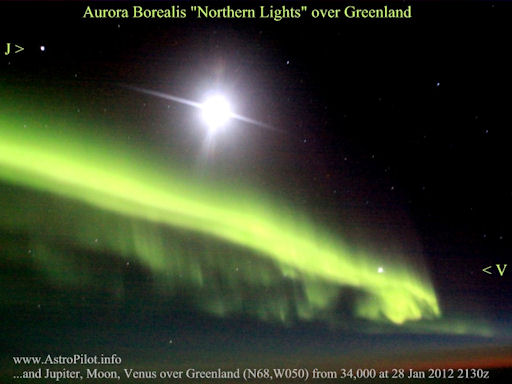CHANCE OF AURORAS: NOAA forecasters estimate a 30% chance of minor geomagnetic storms on Jan. 30th in response to a possible glancing blow from a coronal mass ejection (CME). The CME is from last Friday's off-center X-flare. High-latitude sky watchers should be alert for auroras. Aurora alerts: text, voice.
On Jan. 28th, pilot Brian Whittaker was flying 34,000 feet over Greenland when he saw the Moon shining down on a vibrant blanket of auroras:
"Jupiter, Venus, and the Moon were lined up just above the auroras," says Whittaker. "It was a very pretty scene."
more images: from Peter Rosen of Abisko, Sweden; from Dionys Moser of Tromsö, Norway; from Arild Heitmann of Sandstrand, Troms, Norway
January 2012 Aurora Gallery
[previous Januaries: 2010, 2009, 2008, 2007, 2005, 2004]

![]()
Solar wind
speed: 341.1 km/sec
density: 0.1 protons/cm3
explanation | more data
Updated: Today at 1446 UT
![]()
X-ray Solar Flares
6-hr max: B4 1307 UT Jan30
24-hr: C1 0440 UT Jan30
explanation | more data
Updated: Today at: 1400 UT
![]()
![]()
![]()
Daily Sun: 30 Jan 12
![]()
![]()
A new sunspot is emerging just south of AR1410. Otherwise, solar activity is very low. Credit: SDO/HMI
![]()
![]()
![]()
Sunspot number: 74
What is the sunspot number?
Updated 29 Jan 2012
Spotless Days
Current Stretch: 0 days
2012 total: 0 days (0%)
2011 total: 2 days (<1%)
2010 total: 51 days (14%)
2009 total: 260 days (71%)
Since 2004: 821 days
Typical Solar Min: 486 days
Updated 29 Jan 2012
The Radio Sun
10.7 cm flux: 110 sfu
explanation | more data
Updated 29 Jan 2012
![]()
![]()
![]()
Current Auroral Oval:
![]()
Switch to: Europe, USA, New Zealand, Antarctica
Credit: NOAA/POES
![]()
![]()
![]()
Planetary K-index
Now: Kp= 0 quiet
24-hr max: Kp= 1 quiet
explanation | more data
![]()
Interplanetary Mag. Field
Btotal: 3.1 nT
Bz: 2.6 nT north
explanation | more data
Updated: Today at 1447 UT
![]()
![]()
![]()
Coronal Holes: 30 Jan 12
![]()
![]()
There are no big coronal holes on the Earthside of the sun. Credit: SDO/AIA.





